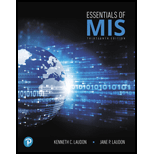
Essentials of MIS (13th Edition)
13th Edition
ISBN: 9780134802756
Author: Kenneth C. Laudon, Jane Laudon
Publisher: PEARSON
expand_more
expand_more
format_list_bulleted
Expert Solution & Answer
Chapter 7, Problem 1RQ
Explanation of Solution
Features of simple network:
- The client computers, server computer, network
operating system software, network interfaces, hub, and a connection medium are the entities of a simple network. - The basic responsible for network operating system software is controlling the network and its functions.
- One client computer is connected to another client computer within the same network.
- Hubs and switches function is sending packets of data to all other linked devices.
- The network helping up web pages to storing data and network operating system.
- The switch has the capability to select a particular destination while the hub sends a packet to all other linked devices.
- The network components links with the connection mediums such as coaxial cables, radio signals or telephone wires.
- The Microsoft Window Server, Linux and Novell Open Enterprise Server are the most commonly used network operating system software...
Explanation of Solution
Principal technologies and trends:
- Client/ Server computing
- Packet switching
- TCP/ IP and Connectivity
Client/ Server computing:
- Client/ Server computing is defined as a distributed computing model where a part of the processing power is placed within cheap client computers and exist in laptops, handled devices or desktops.
- It also allows for computing to departments, factory floors, workgroups and other parts of a business that couldn’t be worked by a centralized architecture.
- The clients are linked to other clients through networks that is controlled by a network server computer.
- It has replaced by centralized mainframe computer.
- The process of the client/ server computing has no longer take place on a central large mainframe computer.
Packet Switching:
- Messages transferring in the internet are divide into fixed size unit of data called packet.
- Messages are divided into packets to increase the performance and reliability of the internet.
- Ιt also improves the effectiveness of the communication line in the internet.
- Packets travel through several routers before it reaches the destination.
- Router is a device that provides a path for the packet to reach the destination...
Expert Solution & Answer
Want to see the full answer?
Check out a sample textbook solution
Students have asked these similar questions
I need to define and discuss the uses of one monitoring or troubleshooting tool in Windows Server 2019. thank you
I would likr toget help with the following concepts:
- Windows Server features
- Windows Server versus Windows 10 used as a client-server network
I need to define and discuss the uses of one monitoring or troubleshooting tool in Windows Server 2019. thank you
Chapter 7 Solutions
Essentials of MIS (13th Edition)
Ch. 7.3 - Prob. 1CQ1Ch. 7.3 - Prob. 2CQ1Ch. 7.3 - Prob. 3CQ1Ch. 7.3 - Prob. 4CQ1Ch. 7.3 - Prob. 5CQ1Ch. 7.3 - Prob. 1CQ2Ch. 7.3 - Prob. 2CQ2Ch. 7.3 - Prob. 3CQ2Ch. 7 - Prob. 1IQCh. 7 - Prob. 2IQ
Ch. 7 - Prob. 3IQCh. 7 - Prob. 4IQCh. 7 - Prob. 5IQCh. 7 - Prob. 6IQCh. 7 - Prob. 1RQCh. 7 - Prob. 2RQCh. 7 - Prob. 3RQCh. 7 - Prob. 4RQCh. 7 - Prob. 5DQCh. 7 - Prob. 6DQCh. 7 - Prob. 7DQCh. 7 - Prob. 8HMPCh. 7 - Prob. 9HMPCh. 7 - Prob. 10HMPCh. 7 - Prob. 11HMPCh. 7 - Prob. 13CSQCh. 7 - Prob. 14CSQCh. 7 - Prob. 15CSQCh. 7 - Prob. 16CSQCh. 7 - Prob. 17CSQCh. 7 - Prob. 18MLMCh. 7 - Prob. 19MLM
Knowledge Booster
Similar questions
- Please solve and answer the questions correctly please. Thank you!!arrow_forwardConsidering the TM example of binary sum ( see attached)do the step-by-step of execution for the binary numbers 1101 and 11. Feel free to use the Formal Language Editor Tool to execute it; Write it down the current state of the tape (including the head position) and indicate the current state of the TM at each step.arrow_forwardI need help on inculding additonal code where I can can do the opposite code of MatLab, where the function of t that I enter becomes the result of F(t), in other words, turning the time-domain f(t) into the frequency-domain function F(s):arrow_forward
arrow_back_ios
SEE MORE QUESTIONS
arrow_forward_ios
Recommended textbooks for you
 Fundamentals of Information SystemsComputer ScienceISBN:9781337097536Author:Ralph Stair, George ReynoldsPublisher:Cengage Learning
Fundamentals of Information SystemsComputer ScienceISBN:9781337097536Author:Ralph Stair, George ReynoldsPublisher:Cengage Learning Principles of Information Systems (MindTap Course...Computer ScienceISBN:9781305971776Author:Ralph Stair, George ReynoldsPublisher:Cengage Learning
Principles of Information Systems (MindTap Course...Computer ScienceISBN:9781305971776Author:Ralph Stair, George ReynoldsPublisher:Cengage Learning Principles of Information Systems (MindTap Course...Computer ScienceISBN:9781285867168Author:Ralph Stair, George ReynoldsPublisher:Cengage Learning
Principles of Information Systems (MindTap Course...Computer ScienceISBN:9781285867168Author:Ralph Stair, George ReynoldsPublisher:Cengage Learning Systems ArchitectureComputer ScienceISBN:9781305080195Author:Stephen D. BurdPublisher:Cengage Learning
Systems ArchitectureComputer ScienceISBN:9781305080195Author:Stephen D. BurdPublisher:Cengage Learning A+ Guide to Hardware (Standalone Book) (MindTap C...Computer ScienceISBN:9781305266452Author:Jean AndrewsPublisher:Cengage Learning
A+ Guide to Hardware (Standalone Book) (MindTap C...Computer ScienceISBN:9781305266452Author:Jean AndrewsPublisher:Cengage Learning


Fundamentals of Information Systems
Computer Science
ISBN:9781337097536
Author:Ralph Stair, George Reynolds
Publisher:Cengage Learning

Principles of Information Systems (MindTap Course...
Computer Science
ISBN:9781305971776
Author:Ralph Stair, George Reynolds
Publisher:Cengage Learning

Principles of Information Systems (MindTap Course...
Computer Science
ISBN:9781285867168
Author:Ralph Stair, George Reynolds
Publisher:Cengage Learning

Systems Architecture
Computer Science
ISBN:9781305080195
Author:Stephen D. Burd
Publisher:Cengage Learning

A+ Guide to Hardware (Standalone Book) (MindTap C...
Computer Science
ISBN:9781305266452
Author:Jean Andrews
Publisher:Cengage Learning